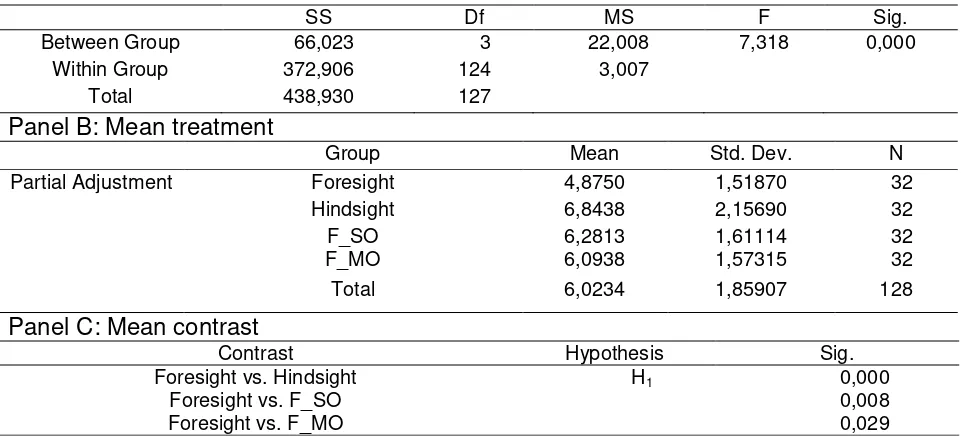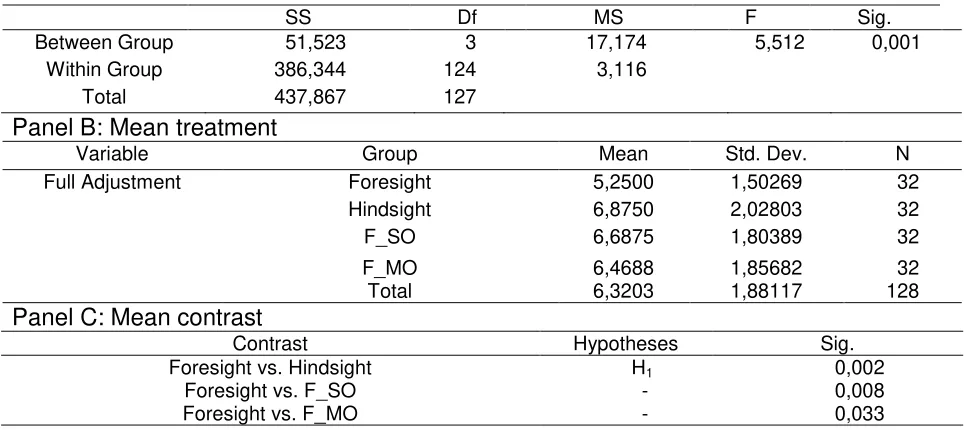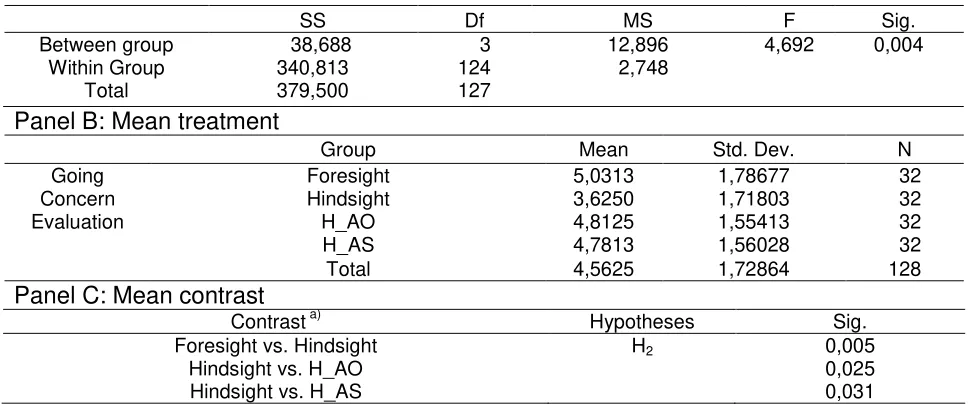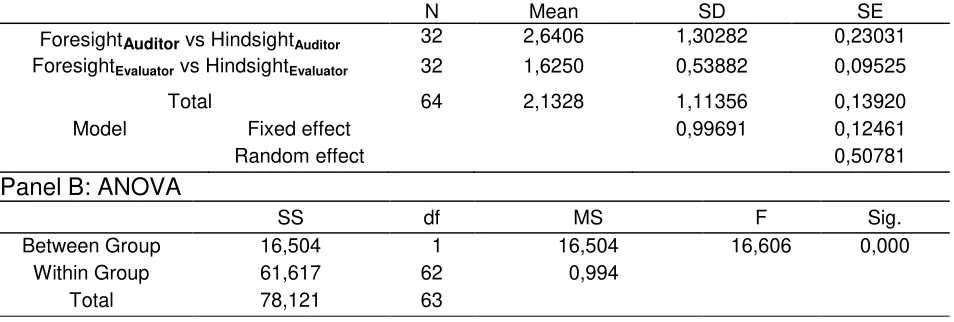Vol. 3. No. 2. March 2013 Issue. Pp. 1
–
13
The Effectiveness of Foresight Decision Aids and Hindsight
Strategy to
Mitigate Auditors’
and E
valuators’
Judgment
Error
I Made Narsa*
This research tests the effectiveness of foresight decision aids (single outcome and multiple outcome) and hindsight strategy (alternative outcome and alternative stakeholder) to mitigate auditors’ and evaluators’ judgment error. Two between subject experimental designs were conducted concurrently involving 282 participants. The results showed that the quality of auditors’ decisions increase and move to evaluators’ perspective. Meanwhile, the quality of evaluators’ decisions increase and move to auditors’ perspective. Other findings showed that both auditors and evaluators tend to pay more attention on negative than positive information.
Keywords:decision aids, mitigation, foresight, hindsight, outcome, judgment error.
JEL Codes:C91, M41 and M49
1. Introduction
Recently, Indonesian public accountant profession has been scrutinized sharply in conjunction with numerous large corporate scandals which involved public accountants. The Government of Indonesia pays serious attention and forms Interdepartmental Committee to arrange a draft of law of public accountant. The draft stated that public accountant can be condemned. Public accountants can become target of litigations and potentially face legal problems. This is the point, that how to improve the quality of auditors’ decision process to avoid legal problems.
When an auditor is facing litigation and accused of doing negligence, the evaluator will evaluate ex post whether the auditor due professional care in the conduct of his/her job ex ante. Auditors are in under uncertainty and have no outcome knowledge during their decision making process, while evaluators have outcome knowledge when evaluating the
auditor’s performance ex ante. Differences in time perspective and the outcome effect is
called hindsight bias (Kinney Jr 1994; Pohl 2007; Schkade & Kilbourne 1991). This is the second point, that how to mitigate hindsight bias experienced by evaluator.
Previous research mitigated judgment error or hindsight bias from one side partially, such as from auditor side (Lowe & Reckers 2000), or from evaluator side (Anderson et al. 1997; Lowe et al. 2002; Narsa 2011). This research mitigated hindsight bias from both sides
simultaneously. The research questions are: do negative outcomes affect auditor’s decision making process, and evaluator’s evaluation process; can foresight decision aids
such as single and/or multiple outcomes mitigate auditor’s foresight bias;
2
can alternative outcomes strategy or stakeholder alternative strategy mitigate evaluator’s hindsight bias; do auditors and evaluators have a different susceptibility subject to cognitive bias; is hindsight bias mitigation strategy more effective in narrowing the gap between auditor and evaluator perspective compared with the foresight decision aids?
The results showed that magnitude of auditors’ predictive judgment error is bigger than evaluators’ evaluative judgment error. Foresight decision aids mitigate predictive judgment error so that the quality of auditors’ decisions increase similar to evaluators’ perspective.
Meanwhile, the hindsight strategies mitigate evaluative judgment error so that evaluators’
decisions were much similar to auditors’ perspective. Statistically, the four mitigation
strategies have no different effectiveness in narrowing the gaps of two perspectives.
The rest of the paper discusses the theoretical justification for the hypotheses developed to address these issues. This is followed by a description of the experiment design used and the presentation of findings and discussion. The final section provides the conclusions, implications, and the limitations of the study.
2. Theoretical Review and Hypotheses Development
Fischhoff (1975, p. 304) stated that “hindsight and foresight differ formally in the information available to the observer. The hindsightful judge possesses outcome knowledge, that is, he knows how things turned out. The foresightful judge does not”. Evaluators possess outcome information because their position in hindsight where the events had already occurred. While, decision makers does not possess such outcome because their position in foresight (Blank et al. 2007; Fischhoff 2007). Foresight bias reflects the inability in foresight to see how things will look in the future and hindsight bias reflects the inability in hindsight to see how things looked in the past (Kamin & Rachlinski 1995). Operationally, foresight bias and hindsight bias are the difference between subjective probabilities of the occurrence of a given outcome estimated by persons who have outcome knowledge and those who do not (Christensen-Szalanski & Willham 1991; Lowe & Reckers 2000; Schkade & Kilbourne 1991).
2.1 Foresight Perspective
The difference in predictive judgment made by subjects who are given a negative outcome and those who are not is called hindsight bias (Christensen-Szalanski & Willham 1991; Schkade & Kilbourne 1991). Research conducted by Lowe (1992), Reimers (1992), and Lowe (2000) found that negative outcome affects predictive and evaluative judgments. Auditors, in an audit engagement, are responsible in evaluating whether substantial doubt exists about entity ability to continue as a going concern in a reasonable period in the future. Auditors must identify information and condition or circumstances (for example: obsolescence condition of inventory; negative profit trend, financial difficulty, labor conflict,
lawsuits, new regulations issuance, patent loss, etc.) to gain confidence about clients’
ability to continue as going concern. Based on the judgment, auditors make decisions such as to what extent auditors adjust obsolete inventory and whether to expose the information in audit report or not. If the auditors believe that there will be a negative outcome in their
3
H1: Auditors who are given negative outcome concerning their audit client will make a
wider adjustment decisions than auditors who are not.
2.2 Hindsight Perspective
Evaluators tend to perceive that certain outcome is a series of occurrences that can be predicted hence the decision maker should be able to avoid a negative outcome. The outcome presented in legal cases is typically negative. The plaintiff usually experiences some undesirable outcome, which initiates litigations. The severity of a negative outcome can have dramatic affects on the size of hindsight bias, with larger bias resulting from more severe negative outcome (Harley 2007; Muller & Stahlberg 2007). Other researchers found that hindsight bias are larger if the subjects were given negative outcome than positive outcome (Casper et al. 1989; Hastie et al. 1999).
H2: Evaluators who are given negative outcome concerning an audit client of a public
accounting firm will consider that the auditor’s decision is worse compared to evaluators who are not given negative outcomes.
2.3 Specific Knowledge Acquisition
Lowe (1992) stated that cognitive bias can be moderated by acquiring specific domain of knowledge. Individuals who do not have knowledge of a certain field may adjust their tasks using cognitive heuristics. Based on this assertion, Christensen-Szalanski (1991) in a meta analysis study coded subjects who have a specific knowledge and/or direct experience related to their job as “familiar”, and coded as “not familiar” for subjects who do not have
them. The result showed that “familiar” subjects significantly experienced lower hindsight bias than “not familiar” subjects.
Auditors have specific knowledge in auditing, so they tend to rely less on the outcomes but more on the knowledge that serves as the basis of auditing process and its circumstances. Meanwhile evaluators lack knowledge on auditing and have limited understanding in factors and circumstances that direct financial and alternative outcomes from audit clients (Guilbault et al. 2004; Jones & Chen 2005). With these limitations evaluators tend to rely on outcomes.
H3: Evaluators are more susceptible of hindsight bias exposure than auditors.
Relying on outcome information reflects a relatively larger hindsight bias for evaluators and tends to be easily affected by bias mitigation strategy. Therefore, if evaluators who experience hindsight bias are aided by a signal to reconsider an alternative outcome or an alternative stakeholder, they will soon alter their judgment process in evaluating ex ante
auditors’ performance.
H4: Hindsight mitigation strategy is more effective than foresight decision aids in
4
3. Research Method
Two experiments are conducted in a parallel order. First, auditors are surrogated by undergraduate accounting students who already passed auditing practice course; Second, evaluators are surrogated by undergraduate law students who already passed the law of criminal procedure and moot court course. Both experiments conducted from May 2012 to September 2012.
Dependent variables for the first experiment are Partial Adjustment (PA) and Full Adjustment (FA). These variables are measured using 10 point scale: score 1 = not at all and score 10 = as wide as possible. The independent variables are two level outcomes: without outcome and negative outcome; and two level foresight decision aids: single outcome and multiple outcomes. Dependent variables for the second experiment are Adjustment Evaluation (AE) and Going Concern Evaluation (GE). These variables are measured using 10 points scale: score 1 = very inaccurate and score 10 = very accurate. Independent variables are two level outcomes: without outcome and negative outcome; and two level mitigation strategy: alternative outcome and alternative stakeholder.
3.1 Case Material and Instrument
Case material used in this research is derived from the material used by Lowe and Reckers (2000) with are adjusted for numbers and context for practicality in Indonesia. Each subject was given a material consisting an instruction booklet, case material, and list of questions. The background of the case is a hypothetical manufacturing company, “PT Buah Hati”, that produces children toys as a client with declining financial performance in the past few years. The case provides a summary of financial items and relevant qualitative information to provide an illustration of the size and internal condition of the company and its business environment. The focus of the scenario is the potential of obsolete inventory.
The core of the first experiment is to ask the auditors to generate decision on the possibilities of adjustments of obsolete inventory to support an unqualified opinion. Auditors are asked to assess relevant factors. Meanwhile the core of the second
experiment is to ask the evaluators to judge whether the auditors’ decision is accurate or
absolutely inaccurate.
3.2 Tasks and Experiment Procedures
5
Other groups are given basic case narration including relevant information factors, but each group receives different treatment. First, foresight+single outcome (F_SO) group (auditors) receive single outcome decision aids. This procedure directs subjects to consider negative outcome potential. Second, foresight+multiple outcomes (F_MO) group (auditors) receive the multiple outcomes decision aids. Subjects are directed to consider the various potential outcomes, positive and negative. Subjects are asked to provide the probability of occurrence of the given outcomes. Third, hindsight+alternative outcome (H_AO) group (evaluators) receive alternative outcome mitigation strategy based on an ex ante client condition. To increase the elaboration process, subjects are asked to assess the probability level of each alternative outcome. Subjects are also asked to identify other outcomes, if any, and provide their probability of occurrence. Fourth, hindsight+alternative stakeholder (H-AS) group (evaluators) receive a potential alternative stakeholder mitigation strategy. In this treatment, it is shown that the auditors have considered their responsibilities to other stakeholders and the potential loss which the stakeholders have to bear if the auditors are to take the opposite decision. Specifically, it is also illustrated that issuance of inappropriately opinion can cause loss to other stakeholders other than plaintiff. After thoroughly understanding the information and instructions, all subjects are asked to answer the questions in the list.
4. Findings and Discussion
4.1 Demographic Data and Manipulation Check
Subjects who participate in both experiment are 282 students, but 26 are omitted due to failure in manipulation check. Furthermore, each cell contains 32 participants. The test result for randomization procedure shows insignificant F test score for all subject characteristics. It means all groups are equivalent.
The test result for two basic assumptions of MANOVA such as equality of covariance matrices and equality of error variance can be fulfilled for both experiments. Box’M test and the Levene’s test shows insignificant F test for all dependent variables. The result of the multivariate analysis to test whether each treatment affects both dependent variables showed that the F test is significant at the level less than one prevent. It can be concluded that each treatment is related to both dependent variables. Between subject test result shows that each treatment group has different effects on each dependent variable and significant at the level less than one percent.
4.2 Existence of Hindsight Bias
6
Table 1: ANOVA Findings for Dependent Variable PA
Panel A: ANOVA
SS Df MS F Sig.
Between Group 66,023 3 22,008 7,318 0,000
Within Group 372,906 124 3,007
Total 438,930 127
Panel B: Mean treatment
Group Mean Std. Dev. N
Partial Adjustment
Foresight 4,8750 1,51870 32
Hindsight 6,8438 2,15690 32
F_SO 6,2813 1,61114 32
F_MO 6,0938 1,57315 32
Total 6,0234 1,85907 128
Panel C: Mean contrast
Contrast Hypothesis Sig.
Foresight vs. Hindsight Foresight vs. F_SO Foresight vs. F_MO
H1 0,000 0,008 0,029
7
Table 2: ANOVA Findings for Depandent Variable FA
Panel A: ANOVA
Table 3: ANOVA Findings for Dependent Variable AE
8
As found in other prior research (Anderson, et al., 1997), this research also finds that the
judges’ evaluation depends on the outcome information. Subjects give worse evaluation on
auditors’ decision when they already knew the negative outcome. Fischhoff (1975) also
find that if the subjects who are given information of outcome and asked several probability ex ante the outcomes occurred, the answers are significantly higher than the subjects who are not informed.
In auditing, Buchman (1985) tests the difference between estimated probabilities of bankruptcy of companies generated by subjects who are already informed accordingly, and with those who are not informed. The finding shows that hindsight subjects settle on a higher probability than the foresight subjects. Brown and Solomon (1987) who used business students in their experiment find different evaluation on investment decisions between hindsight and foresight subjects.
Table 4: ANOVA Findings for Dependent Variable GE
Panel A: ANOVA
Variance analysis of foresight bias magnitude (Table 5) shows F = 16.606 (p = 0.000), it means that there is a difference in magnitude of cognitive bias between auditors and evaluators. However, the mean magnitude of hindsight bias experienced by auditors is higher than evaluators. The results do not support H3 that evaluators would experience a
larger cognitive bias compared to auditors.
9
Table 5: Magnitude of Hindsight Bias of Auditors vs Evaluators
Panel A: Descriptive statistic
N Mean SD SE
ForesightAuditor vs HindsightAuditor 32 2,6406 1,30282 0,23031 ForesightEvaluator vs HindsightEvaluator 32 1,6250 0,53882 0,09525
Total 64 2,1328 1,11356 0,13920
Model Fixed effect 0,99691 0,12461
Random effect 0,50781
Panel B: ANOVA
SS df MS F Sig.
Between Group 16,504 1 16,504 16,606 0,000
Within Group 61,617 62 0,994
Total 78,121 63
Specific knowledge possessed by auditors, in fact, does not moderate hindsight bias. This result is opposite to the research conducted by Christensen-Szalanski et al. (1991) who finds that subjects with specific knowledge significantly experience less hindsight bias than subject with no specific knowledge. Other research, Lowe (1992), does not find evidence that acquiring specific knowledge can play a role as a moderator to hindsight bias. This research documented that both auditors and evaluators are exposed by the same magnitude of cognitive bias.
Actually, Christensen_Szalanski et al. (1991) use subject with direct experience with their job, meanwhile this research uses inexperienced subjects. The difference in experience could be a noted as the source of potential problem of how the results are contradictory with the result of prior research. Novice auditors in this experiment do not have direct experience in auditing tasks, so when they are faced with a prediction task they can not recall the accumulated experience and knowledge in their memory. Consequently, when they are given the information about predictive outcome, they tend to rapidly revise their prior decision. On the other hand, novice judges who conduct evaluations task also do not have direct experience as a judge, so they tend to rely on the facts that the outcomes is negative. Therefore, although they are asked to disregard as if they do not know any outcome, they do not radically change their evaluation. This behavior can be explained using the primacy effect theory. According to this theory, the subjects consider the first time information they received as more important than the subsequent information. Hartono
(2004, p. 27) calls it as “the attention decrement effect”, that the last evidence receives less
attention than earlier evidence. In this case, when subject receive negative outcomes, they tend to form a belief that the auditors have failed or been wrong in the decision making process. Subsequent information of an alternative outcome will not forcefully alter their belief.
4.4 Mitigation Strategy Effectiveness
10
Although the mean single outcome strategy of 0.5625 has the largest difference with the mean alternative stakeholder strategy of 1.1084, it is not sufficient to conclude that the alternative stakeholder strategy is more effective than the single outcome strategy (p = 0.234). Based on the test results, hypothesis eight is not supported by empirical evidence. It means that the strategy which orientation is to change the evaluation process of judges has statistically insignificant different effectiveness with the other strategies.
Lowe and Recker (1994) find that alternative outcome strategy is effective in reducing
evaluators’ hindsight bias. Meanwhile, Anderson et al. (1997) finds otherwise, that
alternative outcome strategy is not effective in decreasing hindsight bias but alternative stakeholder strategy is effective. In this case, there are differences in the subjects they use. Lowe and Recker use jurors to be, but Anderson et al. use experienced judges. This research uses law students. We expect that experience factors and subject groups may have a moderating effect in hindsight bias.
Hindsight bias experienced by auditors is at level 1.97. After they are given a single outcome mitigation strategy the bias magnitude turns to 1.41. Therefore, single outcome decision aids can mitigate the bias by 0.56 (28.57%). On the evaluators’ side, hindsight bias magnitude before given a mitigation strategy is 1.41, and then after given the alternative outcome mitigation strategy the magnitude turns to 0.81. This means that the
mitigation strategy from the evaluators’ side can mitigate the bias by 0.59 (42.2%). The
11
Table 6: ANOVA Finding for Effectiveness of Mitigation Strategy to Mitigate Predictive and Evaluative Judgment Error
Contrasa) Mitigation Strategy Hipothesis Sig F_SO vs F_MO
Auditors are asked to provide assessment of importance of the information factors before deciding to make adjustment related to the obsolescence of inventory. So are the subject
judges, before they evaluate the auditors’ decision.
Each group of information is composited, then subtracted, resulting in a net score. The binomial test result shows that auditors of foresight group have shown statistically no significant difference. This means that the negative information is not more important than the positive information, vice versa. For groups: hindsight, foresight+SO and foresight+MO, all have a negative net score. The binomial test result shows that there are significant differences between negative and positive information, which means that the subjects consider negative information has a higher probability to occur when conducting an adjustment decision. Evaluators in general also expect the auditors consider more negative information when decisions making process.
5. Conclusion, Limitations and Implications
5.1 Conclusion
12
to the expectation of the evaluators in hindsight. On the contrary, evaluators’ perception in
evaluating auditors’ performance ex ante can move closer to the foresight perspective.
Auditors tend to be more susceptible to cognitive bias exposure than evaluators. The magnitude of judgment error experienced by auditors is more than evaluators. Therefore, it is easier to change the thinking process of auditors to the hindsight perspective than to change the evaluators to the foresight perspective. The results show that four mitigating strategy conducted in narrowing the gap provides relatively the same moderating effect. The other hand, auditors in making a decision are found to pay more attention to negative than positive information. This finding is consistent with the conservative attitude possessed by auditors.
5.2 Implications
The findings provide new insight and bring implications to the development of psychosocial theory in Indonesia, especially in the implementation in auditing. This research also (1) provides the first empirical evidence and explanation on hindsight bias phenomenon in Indonesia, and its mitigation strategy, and (2) serves as the pioneer for subsequent research in further discovering the hindsight bias and in testing the various mitigation strategies. In addition, (3) the case material that use the obsolescence of inventory, will inspire the development of case material on other fields, such as internal control system, budgeting, managerial performance evaluation, and so on. The practical implication of this research is generally related to the improvement of planning quality, auditing jobs, and
auditors’ legal liability. The results can be implemented through management control system and as guidance for the accounting profession in determining the appropriate strategy in improving planning quality and auditing tasks.
5.3 Limitations and Suggestions
Findings in this research indicate that experience may affect the magnitude of cognitive bias and its mitigation strategy effectiveness. The next research should retest this research model using experienced auditors and/or judges as subjects. Second, case materials used in these experiments are only about one aspect of auditing practice that is the obsolescence of inventory. It does not widely cover all setting of the real world in auditing practice. It is necessary to consider using other case materials, such as internal control system, bankruptcy cases, taxes cases, and so on. Third, considering that auditing decision is more of a collective decision of a team or group, the next research should deliberate on using a group as decision making subjects.
References
Anderson, JC, Jennings, MM, Lowe, DJ & Reckers, PMJ 1997, 'The Mitigation of Hindsight Bias in Judges' Evaluation of Auditor Decision', Auditing: A Journal of
Practice & Theory, vol. 16, no. 2, pp. 20-39.
Blank, H, Musch, J & Pohl, RF 2007, 'Hinsight Bias: On Being Wise After Event', Social
Cognition, vol. 25, no. 1, pp. 1-9.
13
Christensen-Szalanski, JJ & Willham, CF 1991, 'The Hindsight Bias: A Meta Analyses',
Organizational Behavior and Human Decision Processes, vol. 40, pp. 50-58.
Fischhoff, B 1975, 'Hindsight # Foresight: The Effect of Outcome Knowledge on Judgment Under Uncertainty', Journal of Experimental Psychology: Human
Perception and Performance, vol. 1, pp. 288-299.
Fischhoff, B 2007, 'An Early History of Hindsight Research', Social Cognition, vol. 25,
Hastie, R, Schkade, DA & Payne, JW 1999, 'Juror Judgments in Civil Cases: Hindsight Effects on Judgments of Liability for Punitive Damages', Law and Human Behavior, vol. 23, no. 5, pp. 597-614.
Jones, KT & Chen, CC 2005, 'The Effect of Audit Outcomes on Evaluators’ Perceptions',
Managerial Auditing Journal, vol. 20, no. 1, pp. 5-18.
Kamin, KA & Rachlinski, JJ 1995, 'Ex Post # Ex Ante: Determining Liability in Hindsight',
Law and Human Behavior, vol. 19, no. 1, pp. 89-104.
Kinney Jr, WR 1994, 'Audit Litigation Research: Profesional Help is Needed', Accounting
Horizons, vol. 8, no. 2, pp. 80-86.
Lowe, DJ & Reckers, PMJ 2000, 'The Use of Foresight Decision Aids in Auditors' Judgments', Behavioral Research in Accounting, vol. 12, pp. 97-118.
Lowe, DJ, Reckers, PMJ & Whitecotton, SM 2002, 'The Effects of Decision-aid Use and Reliability on Jurors' Evaluations of Auditor Liability', The Accounting Review, vol. 77, no. 1, pp. 185-202.
Lowe, DJ 1992, 'An Empirical Examination of The Hindsight Bias Phenomenon in Evaluation of Auditor Decisions', Desertation, Arizona State University.
Muller, PA & Stahlberg, D 2007, 'The Role of Surprise in Hindsight Bias: A Metacognitive Model of Reduced and Reversed Hindsight Bias', Social Cognition, vol. 25, no. 1, pp. 165-184.
Narsa, IM 2011, 'Strategi Foresight untuk Mengubah Perspektif Ex Ante ke Perspektif Ex Post dalam Proses Keputusan Auditor Independen', Jurnal Akuntansi dan
Keuangan Indonesia, vol. 8, no. 2, pp. 141-156.
Pohl, RF 2007, 'Ways to Assess Hindsight Bias', Social Cognition, vol. 25, no. 1, pp. 14-31.
Reimers, JL & Butler, SA 1992, 'The Effect of Outcome Knowledge on Auditors’
Judgmenetal Evaluations', Accounting, Organizations and Society, vol 17, no. 2, pp. 185-194.



